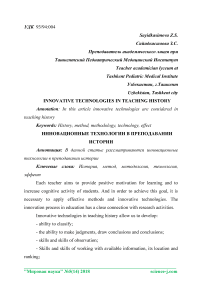Innovative technologies in teaching history
Автор: Sayidkasimova Z.S.
Журнал: Мировая наука @science-j
Рубрика: Основной раздел
Статья в выпуске: 5 (14), 2018 года.
Бесплатный доступ
In this article innovative technologies are considered in teaching history
History, method, methodology, technology, effect
Короткий адрес: https://sciup.org/140263636
IDR: 140263636
Текст научной статьи Innovative technologies in teaching history
Each teacher aims to provide positive motivation for learning and to increase cognitive activity of students. And in order to achieve this goal, it is necessary to apply effective methods and innovative technologies. The innovation process in education has a close connection with research activities.
Innovative technologies in teaching history allow us to develop:
-
- ability to classify;
-
- the ability to make judgments, draw conclusions and conclusions;
-
- skills and skills of observation;
-
- Skills and skills of working with available information, its location and ranking;
-
- Experimenting skills;
-
- cognitive abilities and needs;
-
- skills in creative design and research.
Innovative technologies include project activities. The method of projects in history lessons is aimed at the formation of abilities that allow effective action in a real life situation. The topics offered as research papers should be understandable to the students. In the process of research, the student tries to solve the problem, puts forward hypotheses, asks questions, draws conclusions. Designing teaches clarity in work, it creates commitment and independence.
Very successfully allows you to combine the established methodical methods of the traditional system and new approaches to learning the system of supporting abstracts, which can be used in history lessons. This system raises the level of understanding and understanding of the studied material, contributes to the systematization of knowledge. Also, the use of reference notes presupposes the management of the cognitive activity of schoolchildren, the development of skills of independent work, self-control.
Innovative technologies in history teaching also include information and communication technologies. The teacher can use presentations and multimedia lessons. In this case, schoolchildren can also independently compile supporting abstracts and present them in the form of a presentation, which simultaneously will be an element of the project activity.
The use of innovative technologies in history lessons allows schoolchildren to develop interpersonal skills, ability to productive activity, the general level of mental development. Students better learn the cause-effect and chronological relationships. The variety of forms and methods of organizing a lesson increases the interest of schoolchildren in the subject, and shapes their historical consciousness.
Used sources:
-
1. Cowie, R., Douglas-Cowie, E., Tsapatsoulis, N., Votsis, G., Kollias, S.,
Fellenz, W., Taylor, J., 2001. Emotion recognition in human–computer interaction. IEEE Signal Processing Magazine 18 (1), 32–80.
-
2. Crystal, D., 1963. A perspective for paralanguage. Le Maître Phonétique
-
3. Crystal, D., 1966. The linguistic status of prosodic and paralinguistic
120, 25–29.
features. Proceedings of the University of Newcastle-upon Tyne Philosophical Society 1, 93–108.
Список литературы Innovative technologies in teaching history
- Cowie, R., Douglas-Cowie, E., Tsapatsoulis, N., Votsis, G., Kollias, S., Fellenz, W., Taylor, J., 2001. Emotion recognition in human-computer interaction. IEEE Signal Processing Magazine 18 (1), 32-80.
- Crystal, D., 1963. A perspective for paralanguage. Le Maître Phonétique 120, 25-29.
- Crystal, D., 1966. The linguistic status of prosodic and paralinguistic features. Proceedings of the University of Newcastle-upon Tyne Philosophical Society 1, 93-108.


